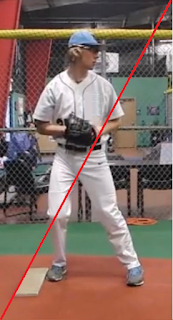Your current Coach does his best to teach you to engage your lower body but continually fails!
Imagine how many hours you’ve spent “trying” to “do” what you know you need to do, your Coach knows you need to “do”, but no one has ever been able to teach you.
We’re proud to be the first to present 3 insanely simple tasks that’ll engage your lower body and, best yet, we do this without asking you to change your current throwing action.
Stop “trying”, start “doing”.
Getting your lower body to drive you results can happen as
soon as your very next pitch.
Before you attack the 3 skills, let’s prepare you to
engage your lower body.
1. First, to eliminate unnecessary movements, work these skills from the stretch, not the wind-up (We’ll address the wind-up in a future post).
2. Make sure the area just in front of the rubber is level. Should this area need some maintenance, simply use the loose dirt around the rubber to fill in front of the rubber.
Now, perform these 3
simple tasks in this order …
1. Begin with your feet one baseball width apart.
2. Simultaneously lift your front leg and bend at the waist.
3. Deliver your pitch so hard you’ll break the webbing on your receiver’s glove.
That’s all there is? It’s really that simple!
By using these skills to get your lower body to bring your throwing
hand through the a consistently tiny release window, your pitches finish closer
to your target than ever and, with little to no extra effort, you produce the
exceptional results you always dreamed possible.
“Biomarkers” unequivocally prove these simple skills work.
Why is this so
simple?
You have control over your back-foot orientation and your foot placements. As we talked about in last week’s post, everything past these 2 actions is a “biomarker” (“biological” + “marker” = your subconscious physiological reactions). The instant you treat your physiological reactions as controllable, you make it physically impossible to have your lower body drive your results.
You have control over your back-foot orientation and your foot placements. As we talked about in last week’s post, everything past these 2 actions is a “biomarker” (“biological” + “marker” = your subconscious physiological reactions). The instant you treat your physiological reactions as controllable, you make it physically impossible to have your lower body drive your results.
The back-foot orientation, foot placements and front leg
lift we present force a subconscious reaction that makes it possible for you to
deliver every pitch into your Catcher’s target, always keep your Team close
enough to win and challenge every Opponent to drive any pitch.
Let us know how
you’re doing?
When you use these skills and still find yourself struggling with your command, send us a pitching motion video or attach a comment to this post. We’ll use your video and comments to resolve the movement that’s currently blocking your lower body from driving your results.
When you use these skills and still find yourself struggling with your command, send us a pitching motion video or attach a comment to this post. We’ll use your video and comments to resolve the movement that’s currently blocking your lower body from driving your results.
Bookmark this post.
Moving forward, every week we’ll present ways to refine these skills and the “biomarkers” (“biological”+ “markers” – see past posts for more on this) associated with each skill.
Moving forward, every week we’ll present ways to refine these skills and the “biomarkers” (“biological”+ “markers” – see past posts for more on this) associated with each skill.
Tell a friend!
Know a Pitcher struggling on the mound, make sure to share this post with them.
Know a Pitcher struggling on the mound, make sure to share this post with them.
Want personal coaching? Please feel free to contact me.
Skip Fast
Expert
Pitching Coach
Professional Pitching Institute
Professional Pitching Institute
E-Mail: skip@propitchinginstitute.com
Cell or Text: 856-524-3248
Cell or Text: 856-524-3248
Copyright ©
2018






